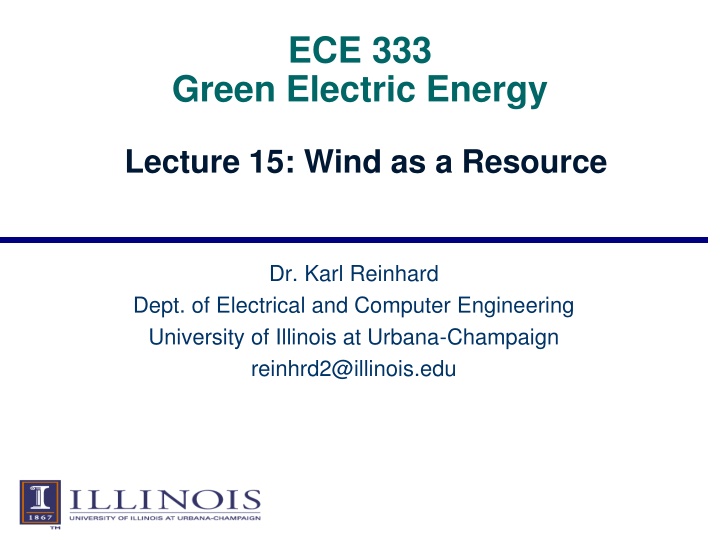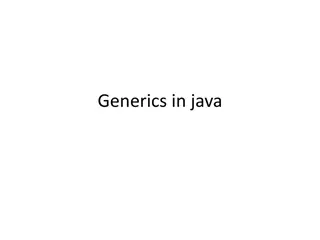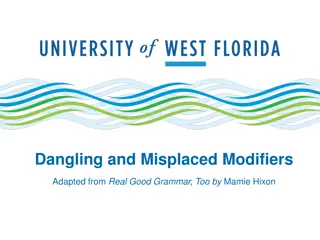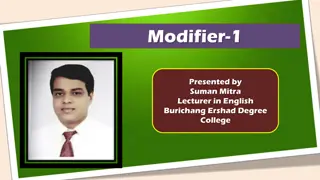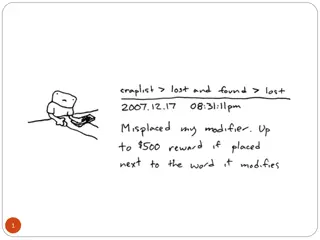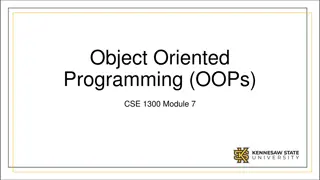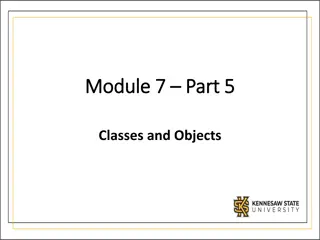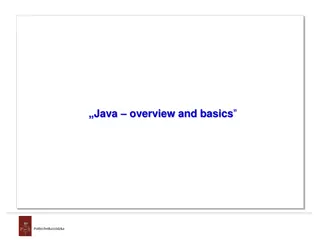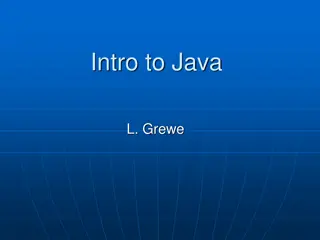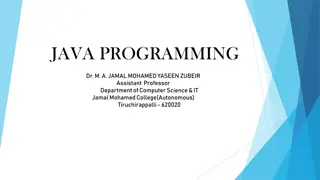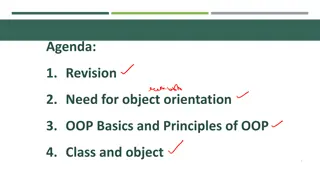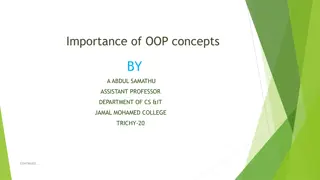Java OOP Language: Defining Classes and Modifiers
Java is a true object-oriented language where all programs revolve around classes encapsulating state and behavior as objects. Classes in Java provide a way to organize related data and methods, acting as templates for creating objects. Key concepts include polymorphism, inheritance, encapsulation, and abstraction. Learn about defining classes, field declarations, methods, and the fundamental components needed for object creation.
Download Presentation

Please find below an Image/Link to download the presentation.
The content on the website is provided AS IS for your information and personal use only. It may not be sold, licensed, or shared on other websites without obtaining consent from the author.If you encounter any issues during the download, it is possible that the publisher has removed the file from their server.
You are allowed to download the files provided on this website for personal or commercial use, subject to the condition that they are used lawfully. All files are the property of their respective owners.
The content on the website is provided AS IS for your information and personal use only. It may not be sold, licensed, or shared on other websites without obtaining consent from the author.
E N D
Presentation Transcript
ECE 333 Green Electric Energy Lecture 15: Wind as a Resource Dr. Karl Reinhard Dept. of Electrical and Computer Engineering University of Illinois at Urbana-Champaign reinhrd2@illinois.edu
Announcements No Homework / Quiz today Homework 7 Posted (Economics and Wind) Quiz 7 Thursday after Spring Break (29 Mar) Reading Chapter 7 Thanks to EOH Volunteers GREAT SUCCCESS Spring Break Safety !! 1
Wind Turbine Sizes A 747 wing span is about 60m; The Washing- ton mon- ument is 169m high 2 http://www.bpwtag.ca/Bruce%20Peninsula%20Wind%20Turbine%20Sizes%202013.jpg
Power in the Wind Consider the kinetic energy of a small air volume with mass m moving at constant velocity v m 1 2mv = 2 KE v Power in the wind (Pw ) constant v A 1 2 v m 2 d m v 1 2 d E dt d m dt = = = 2 constant A P v w dt = A x V V d m d = Density defintion: d dt d x dt V = = A v A = V V d m d m d t d m dt d d d t = 1 2 1 2 d m d t = = v A 2 3 P v w = A v 3
Power in the Wind (cont) A v m 1 2 = v A 3 w P PW (Watts) = power in the wind (kg/m3) = air density (1.225kg/m3at 15 C and 1 atm) A (m2) = the cross-sectional area that wind passes through v (m/s) = windspeed normal to A (1 m/s = 2.237 mph) Fundamental relationship to be used throughout subsequent work !! 4
Power in the Wind (cont) 1 2 = v A 3 w P Power increases ?3 2 v 8 Pw Energy in 20 mph winds @ 1 hr = Energy in 8 mph winds @ 8 hr Nonlinear, so we cannot use average wind speed For comparison, summer solar is about 600 ? ?2 5
Power in the Wind (cont) 1 2 = v A 3 w P Pw A For a conventional HAWT, A = ( /4) D2 Co$t is somewhat proportional to blade diameter This in part explains why larger wind turbines are more co$t effective (plus, as we shall see, because they are higher, the winds are stronger) Pw blade diameter squared 6
Example: Wind Energy Passing though 1 m2 1 2 = 3 Energy A v t 100 hours of 6 m/s winds 1 2 ( ) ( ) 3 = 3 2 Energy 1.225 kg/m (1m ) 6 m/s 100 h = 13,230 Wh 50 hours of 3 m/s winds and 50 hours of 9 m/s winds - *the average wind speed is 6 m/s ( Energy (3 ) 1.225 kg/m (1m ) 3 m/s 50 h 2 ( Energy (9 ) 1.225 kg/m (1m ) 9 m/s 50 h 2 1 ) ) ( ( ) ) ms ms 3 = 3 2 = 827 Wh 1 3 = 3 2 = 22,326 Wh total = 23,152 Wh Don t use average wind speed! 7
Air Density Temperature and Pressure = = = = = pressure (atm) volume (m ) mass (mol) ideal gas constant (8.2056 10 temperature ( K) M.W.= gas molecular weight (g/mol) = 28.97(g/mol) air density (kg/m ) = P V n R T Ideal gas Law 3 = PV nRT 3 -5 ) m K mol o 3 (mol) . .(g/mol) 10 (kg/g) ( ) M.W. 10 RT p T n M W = 3 V m 3 p = 3 353.1 (atm) = o ( K) Air density is greater at lower temperatures For example, in comparing 90 F (305o K) to 10 F (265.3o K), ratio is about 1.15:1 8
Air Density Altitude Correction FIGURE 7.15 A column of air in static equilibrium used to determine the relationship between air pressure and altitude. Masters, Gilbert M. Renewable and Efficient Electric Power Systems, 2nd Edition. dP dz = + = g dz ( ) ( ) dP P z dz P z = g We get a differential equation in terms of pressure: dP dz= 4 1.18510 e = H 4 1 atm P 1.185 10 P where H is in meters 9
Air Density Temperature and Altitude Impacts Density variation wrt temperature and altitude is given by z T 353.1exp( 0.0342 ) = 3 o kg/m , where T ( K) and z (m) above sea level T If z = 0 and T = 273.16 + 15, then = 1.225 kg/m3 If z = 200 and T = 273.16 + 35, then = 1.225 kg/m3 1.120 (about 91% of sea level, 15 degree C value) 10
Elevation & Terrain Roughness Impacts on Pw Since power increases with the cube of wind speed, we can expect a significant economic impact from even a moderate increase in wind speed There is a lot of friction in the first few hundred meters above ground smooth surfaces (like water) are better Wind speeds are greater at higher elevations tall towers are better Forests and buildings slow the wind down a lot 11
Elevation & Terrain Roughness Impacts on Pw v v H H = 0 0 = friction coefficient given in Table 6.3 v = wind speed at height H v0 = wind speed at height H0 (H0 is usually 10 m) Typical open terrain = 1/7 Large city, = 0.4; Small town, = 0.3; High crops, = 0.2, Calm water or hard ground, = 0.1 12
Elevation & Terrain Roughness Impacts on Pw Alternative formulation (used in Europe) ln( ln( / ) / ) l v v H l H = 0 0 lis the roughness length given in Table 7.2 Note that both equations are just approximations of the variation in wind speed due to elevation and roughness the best thing is to have actual local measurements 13
Elevation & Terrain Roughness Impacts on Pw Combining earlier equations we get 3 3 P P v v H H = = 0 0 0 The other constants in the power in the wind equation are the same, so they just cancel: 1 2 1 2 3 Av P P = 3 Av 0 0 14
Elevation & Terrain Roughness Impacts on Pw FIGURE 7.16 Increasing wind speed (a) and power ratios (b) with height for various friction coefficients using a reference height of 10 m. Masters, Gilbert M. Renewable and Efficient Electric Power Systems, 2nd Edition. For a small town, windspeed at 100 m is twice that at 10 m Areas with smoother surfaces have less variation with height 15
Example: Rotor Stress Estimate Wind turbine with hub at 50-m and a 30-m diameter rotor, = 0.2 Find the ratio of power in the wind at highest point to lowest point 65 m 3 0.2 65 35 P P = = 1.45 50 m 0 Power in the wind at the top of the blades is 45% higher! 35 m Picture may not be to scale 16
Maximum Rotor Efficiency Betzs Law Two extreme cases, and neither is consistent with our intuition Downwind velocity is zero turbine extracted all of the power Downwind velocity is the same as the upwind velocity turbine extracted no power The maximum power point lies between the extremes Albert Betz (1885 1968), German physicist Graduated 1910 from Technical University of Berlin w/ naval engineering degree. Earned PhD in 1919 for his work on Ship Propellers with Minimum Loss of Energy Betz' law states that, independent wind turbine design, no more than 16/27 (or 59%) of wind s kinetic energy can be converted to mechanical energy. https://alchetron.com/Albert-Betz 17
Maximum Rotor Efficiency Betzs Law Constraint on the ability of a wind turbine to convert kinetic energy in the wind into mechanical power Consider the wind passing though a turbine it slows and the pressure is reduced so it expands FIGURE 7.17 Approaching wind slows and expands as a portion of its kinetic energy is extracted by the wind turbine, forming the stream tube shown. Masters, Gilbert M. Renewable and Efficient Electric Power Systems, 2nd Edition. 18
Power Extracted by The Blades 1 2 ( ) m = 2 2 (Eqn 7.21 Masters) P v v b d = mass flow rate of air within stream envelop v = upwind undisturbed wind speed vd = downwind wind speed The wind power converted to mechanical power is the difference between upwind and downwind airstream powers Easiest to determine at the plane of the rotor because we know the cross sectional area A Then, the mass flow rate is m = (Eqn 7.22 Masters) Av 19 b
Wind Mass Flow Rate Assume the velocity through the rotor vb is the average of upwind velocity v and downwind velocity vd v v v Recall v v + + d m d t = d m A = d = A v 2 b 2 Then v v + Opening Argument 1 2 ( ) = 2 2 (Eqn 7.23 Masters) d P A v v 1 2 ( ) b d 2 m = 2 2 P v v b d Define dv v = , will be less than 1.0 (Eqn 7.24 Masters) Then substituting for vd to get the power extracted + 1 2 v v ( ) = 2 2 2 (Eqn 7.25 Masters) P A v v b 2 20
Power Extracted by the Blades + 1 2 v v ( ) = 2 2 2 P A v v b 2 + 3 2 3 v 3 3 3 v v v v v ( ) 2 2 2 = - + - v v 2 2 2 2 2 3 v ( ) ( ) + + 2 = 1 - 1 2 v 3 )( ) ( + 2 = 1 1 2 1 2 1 2 )( ) ( = + 3 2 1 1 bP Av PW = Power in the wind CP = Rotor efficiency 21
Maximum Rotor Efficiency Find the wind speed ratio that maximizes the rotor efficiency, CP From the previous slide 2 3 1 2 1 2 )( ) ( = + 2 1 1 = - + - C P 2 2 2 Set the derivative of rotor efficiency to zero and solve for : C C C 1 3 + = 2 = -2 0 P + = 2 = 3 2 1 0 P 1 3 ( )( ) = maximizes rotor efficiency + = = 3 1 1 0 P 22
Maximum Rotor Efficiency Plug the optimal value for back into CP to find the maximum rotor efficiency: 1 2 1 3 1 3 16 27 = + = 1 1 = 59.3% C (Eqn 7.29 Masters) P 2 The maximum efficiency of 59.3% occurs when air is slowed to 1/3 of its upstream rate Called the Betz efficiency or Betz law 23
Maximum Rotor Efficiency Rotor efficiency CPvs. wind speed ratio FIGURE 6.10 The blade efficiency reaches a maximum when the wind is slowed to 1/3 of its upstream value. Masters, Gilbert M. Renewable and Efficient Electric Power Systems, 1st Edition 24
Tip-Speed Ratio (TSR) Efficiency is a function of how fast the rotor turns Tip-Speed Ratio (TSR) is the speed of the outer tip of the blade divided by wind speed Rotor tip speed Wind speed rpm D = Tip-Speed-Ratio (TSR) = (Eqn 7.30 Masters) 60v D = rotor diameter (m) v = upwind undisturbed wind speed (m/s) rpm = rotor speed, (revolutions/min) One meter per second = 2.24 miles per hour 25
Tip-Speed Ratio (TSR) TSR for various rotor types blade turns too slow wind passes through without hitting blade; too fast turbulence Rotors w/ fewer blades reach their maximum efficiency at higher tip-speed ratios FIGURE 7.18 Rotors with fewer blades reach their optimum efficiency at higher rotational speeds. Masters, Gilbert M. Renewable and Efficient Electric Power Systems, 2nd Edition 26
